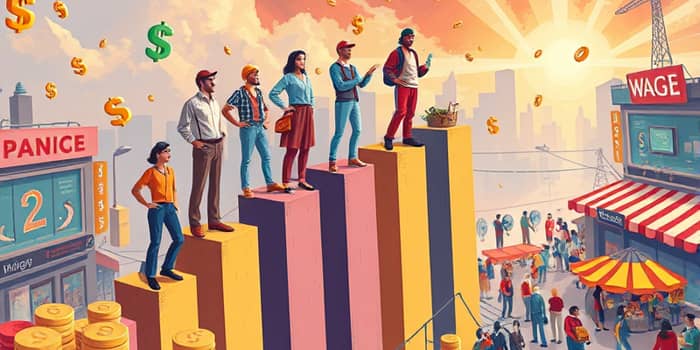
Understanding how wages adjusted for inflation drive consumer behavior can illuminate the health of an entire economy. This article explores the mechanics of real wages, their calculation, historical trends, and implications for long-term demand and policy.
At its core, a real wage reflects true purchasing power by adjusting nominal earnings for inflation. While nominal wages denote the dollar amount paid, they can be misleading if price levels rise faster than paychecks.
Real wages measure what a worker can actually buy. Without this adjustment, one might see a pay increase on paper but ignore erosion of buying capacity when prices surge. Economists rely on price indices—most commonly the Consumer Price Index (CPI)—to convert nominal figures into real terms.
Several formulas translate nominal wages into real values. One simple method subtracts the inflation impact directly:
Real Wage = Nominal Wage − (Nominal Wage × Inflation Rate)
A more precise ratio approach divides the nominal figure by one plus the inflation rate:
Real Wage = Nominal Wage / (1 + Inflation Rate)
Using the CPI index yields another common formula:
Real Wage = (Nominal Wage × CPI Base Year) / CPI Current Year
These examples illustrate how modest inflation can significantly reduce earnings if nominal increases don’t keep pace.
Over recent decades, many developed economies have seen nominal wages rise steadily while real wages remained flat or declined. In periods like the 1970s stagflation, high inflation outpaced pay growth, slashing purchasing power and dampening consumption.
Long-term trends matter because persistent real wage stagnation erodes confidence and curbs demand for non-essential goods.
Real wage growth directly drives aggregate demand by increasing consumer purchasing power. When workers earn more in real terms, they buy more goods and services, stimulating production across sectors.
Because consumption comprises a substantial share of GDP, sustained real wage increases are vital for long-term economic expansion.
Governments and central banks monitor real wages closely when crafting fiscal and monetary policies. Indexed adjustments, such as cost-of-living allowances for social benefits, aim to preserve standard of living for vulnerable groups.
Minimum wage debates often hinge on real purchasing power. Legislators propose floor increases when evidence shows wage erosion in low-income communities, seeking to boost consumer spending without sparking excessive inflation.
In labor negotiations, unions press for cost-of-living adjustments to ensure contracts protect members against rising prices. Employers balance these demands against labor costs and competitiveness.
Despite policy tools, many advanced economies face real wage stagnation driven by automation, globalization, and shifting labor markets. Companies may offshore work or invest in technology rather than raise pay, pressuring wages at home.
Income inequality compounds the problem. Higher-income groups often benefit from asset appreciation, while lower-income workers bear the full brunt of price increases, further suppressing aggregate demand.
To foster long-term demand, policymakers and businesses must collaborate on strategies that include:
By prioritizing sustainable real wage growth, economies can strengthen consumer confidence, drive investment, and ensure that rising productivity translates into broader prosperity.
References













